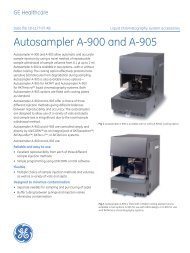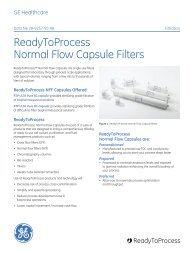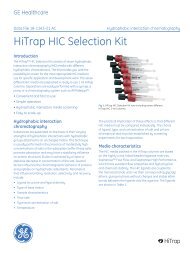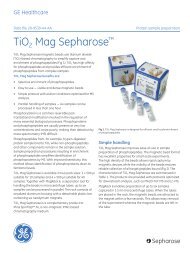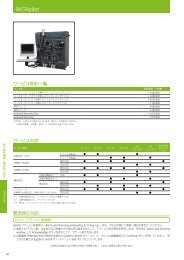[PDF] Data File: rProtein A Sepharose Fast Flow
[PDF] Data File: rProtein A Sepharose Fast Flow
[PDF] Data File: rProtein A Sepharose Fast Flow
You also want an ePaper? Increase the reach of your titles
YUMPU automatically turns print PDFs into web optimized ePapers that Google loves.
GE Healthcare<br />
<strong>Data</strong> <strong>File</strong> 18-1113-94 AE<br />
Affinity chromatography<br />
<strong>rProtein</strong> A <strong>Sepharose</strong> <strong>Fast</strong> <strong>Flow</strong><br />
<strong>rProtein</strong> A <strong>Sepharose</strong> <strong>Fast</strong> <strong>Flow</strong> is an affinity medium,<br />
designed for the purification of monoclonal and polyclonal<br />
antibodies at both laboratory and process scale. It has the<br />
following characteristics:<br />
• Very high dynamic binding capacity for monocloral<br />
antibodies, with high recovery and high purity<br />
• No mammalian components involved during the<br />
manufacturing process<br />
• Easy to scale up<br />
Characteristics<br />
The recombinant protein A is produced in E. coli and has<br />
been specially engineered to favour an oriented coupling<br />
giving a matrix with enhanced binding capacity. The epoxy<br />
based coupling ensures low ligand leakage. The specificity<br />
of the recombinant protein A for the Fc region of IgG is<br />
similar to native protein A and provides excellent purification<br />
in one step. The high capacity, low ligand leakage and a well<br />
established base matrix make <strong>rProtein</strong> A <strong>Sepharose</strong> <strong>Fast</strong><br />
<strong>Flow</strong> ideal for purification of monoclonal antibodies from lab<br />
to process scale. The basic characteristics are summarized<br />
in Table 1.<br />
Enhanced binding capacity due to oriented<br />
coupling<br />
The recombinant protein A has been engineered to include<br />
a C-terminal cysteine. The epoxy chemistry is controlled<br />
to favour a thioether coupling, providing single point<br />
attachment of the protein A, see Figure 1. The oriented<br />
coupling enhances the binding of IgG. This is illustrated in<br />
Figure 2 showing breakthrough curves of human IgG for four<br />
different commercially available protein A matrices.<br />
The binding capacity, at 5% breakthrough (10 cm bed<br />
height, 190 cm/h flow velocity), was 40 mg hIgG/ml bed<br />
volume for <strong>rProtein</strong> A <strong>Sepharose</strong> <strong>Fast</strong> <strong>Flow</strong>, compared<br />
with 27 mg/ml for Competitor A, 24 mg/ml for Protein A<br />
<strong>Sepharose</strong> 4 <strong>Fast</strong> <strong>Flow</strong> (native protein A, CNBr coupled) and<br />
for Competitor B.<br />
<strong>rProtein</strong> A <strong>Sepharose</strong> <strong>Fast</strong> <strong>Flow</strong> is a high capacity medium for purification of<br />
immunoglobulins at lab and process scale.<br />
OH<br />
Fig 1. C-terminal cysteine favours oriented thioether coupling.<br />
0.5<br />
0.4<br />
0.3<br />
0.2<br />
0.1<br />
A 280nm<br />
0<br />
S<br />
<strong>rProtein</strong> A <strong>Sepharose</strong> <strong>Fast</strong> <strong>Flow</strong><br />
Protein A <strong>Sepharose</strong> 4 <strong>Fast</strong> <strong>Flow</strong><br />
Competitor A<br />
Competitor B<br />
<strong>rProtein</strong> A<br />
0 5 10 15 20 25 30 35 40 45 50<br />
(mg hIgG/ml gel)<br />
Fig 2. Breakthrough curves of hIgG for four different Protein A media.<br />
Examples of sample loads and recoveries when purifying<br />
some monoclonal antibodies are listed in Table 2.
Table 1. Characteristics of <strong>rProtein</strong> A <strong>Sepharose</strong> <strong>Fast</strong> <strong>Flow</strong>.<br />
Composition<br />
highly cross-linked 4% agarose<br />
Particle size 60–165 µm<br />
Ligand<br />
recombinant protein A (E. coli)<br />
Ligand density<br />
approx. 6 mg Protein A/ml medium<br />
Coupling chemistry<br />
epoxy<br />
Binding capacity<br />
total<br />
approx. 50 mg human IgG/ml medium<br />
dynamic 1<br />
min 30 mg human IgG/ml medium<br />
Chemical stability<br />
No significant change in chromatographic<br />
performance<br />
after 1 week storage using 8 M urea,<br />
6 M gua-HCl, 2% benzyl alcohol or 20%<br />
ethanol<br />
Cleaning-In-Place stability No significant change in chromatographic<br />
performance after 100 cycles normal use<br />
at room temperature, which corresponds<br />
to a total contact time of 16.7 hours using<br />
50 mM NaOH+1 M NaCl or 50 mM NaOH +<br />
1 M Na 2 SO 4 or 6 M Gua-HCl<br />
Recommended pH<br />
working range 3–10<br />
cleaning-in-place 2–11<br />
Recommended<br />
working flow velocity 30–300 cm/h<br />
Temperature stability 2 4–40 °C<br />
Delivery conditions<br />
20% ethanol<br />
1 Determined at 10% breakthrough by frontal analysis at a linear flow rate of<br />
100 cm/h in a column with a bed height of 5 cm.<br />
2 Recommended long term storage conditions: +4 to +8 °C, 20% ethanol.<br />
Table 2. Purification of some monoclonal antibodies with <strong>rProtein</strong> A<br />
<strong>Sepharose</strong> <strong>Fast</strong> <strong>Flow</strong>.<br />
Sample load<br />
(mg IgG/ml<br />
Recovery<br />
Monoclonal IgG bed volume) (%)<br />
IgG 1 , mouse 1 15 83<br />
IgG 2a , mouse 1 11 97<br />
IgG 2b , mouse 1 23 75<br />
IgG 1 , humanised 2 , * 32 100<br />
IgG g2a , mouse 3 , * 8 80<br />
1 Column: XK 16/20, 4.8 cm bed height, 9.6 ml bed volume<br />
Sample: MAb concentrations, 0.2–0.3 mg/ml<br />
Buffer A: 20 mM sodium phosphate, pH 7.0 (+ 3M NaCl for IgG1, mouse)<br />
Buffer B: 0.1 m sodium citrate/NaOH, pH 3.0–4.5<br />
<strong>Flow</strong> velocity: 150 cm/h<br />
2 Column: 10 mm i.d., 8.2 cm bed height, 6.4 ml bed volume<br />
Sample : MAb concentration 2 mg/ml<br />
Buffer A: 50 mM glycine, 0.25 M NaCl, pH 8.0<br />
Buffer B: 0.1 M glycine, pH 3.5<br />
<strong>Flow</strong> velocity: 50 cm/h<br />
3 Column: 10 mm i.d., 10 cm bed height, 8 ml bed volume<br />
Sample : MAb concentration 0.1 mg/ml<br />
Buffer A: 50 mM glycine/sodium glycinate, pH 8.8<br />
Buffer B: 50 mM sodium acetate/50 mM sodium citrate, pH 3.5<br />
<strong>Flow</strong> velocity: 300 cm/h<br />
* Courtesy of Celltech Biologics Plc., UK.<br />
Highly purified recombinant protein A<br />
The recombinant protein A (E. coli) is produced in validated<br />
fermentation and downstream processes. In addition,<br />
no mammalian components are involved in either the<br />
fermentation process or the purification of the ligand. The<br />
purification process contains several chromatographic steps<br />
(but no affinity step with human IgG). Each batch of protein<br />
is tested, using validated Quality Control (QC) methods,<br />
for IgG binding activity (>95%), electrophoretic purity and<br />
reversed phase- (RP-) HPLC purity (>98%), as well as for<br />
endotoxin content (
Table 4. Leakage levels of protein A measured with non-competitive ELISA.<br />
Protein A matrix<br />
<strong>rProtein</strong> A <strong>Sepharose</strong> <strong>Fast</strong> <strong>Flow</strong> 1 10–30<br />
<strong>rProtein</strong> A <strong>Sepharose</strong> <strong>Fast</strong> <strong>Flow</strong> 2 15<br />
<strong>rProtein</strong> A <strong>Sepharose</strong> <strong>Fast</strong> <strong>Flow</strong>3 5<br />
Protein A <strong>Sepharose</strong> 4 <strong>Fast</strong> <strong>Flow</strong> 1 5–10<br />
Competitor B 1 180–330<br />
Protein A conc. in eluate<br />
(ng protein A/mg IgG)<br />
1 Polyclonal human IgG, sample load+ 50 mg/ml bed volume elution pH 3.0.<br />
2 Mouse IgG 2a , sample load 9 mg/ml bed volume, elution pH 4.0.<br />
3 Mouse IgG 2b , sample load 23 mg/ml bed volume, elution pH 3.0.<br />
+ Different levels of breakthrough for the different media (see Figure 2).<br />
Operation<br />
Method development<br />
As for most affinity chromatography media, <strong>rProtein</strong> A<br />
<strong>Sepharose</strong> <strong>Fast</strong> <strong>Flow</strong> offers high selectivity which renders<br />
efficiency related parameters such as sample load, flow<br />
rate, bead size and bed height less important for resolution.<br />
The primary aim of method optimization is to establish<br />
the conditions that will bind the largest amount of target<br />
molecule, in the shortest time and with the highest product<br />
recovery.<br />
Column: HiTrap SP (1 ml)<br />
Sample: Purified antibody (0.61 mg) spiked with recombinant protein A (1.8 mg)<br />
Buffer A: 20 mM sodium citrate, pH 5.2<br />
Buffer B: 20 mM sodium citrate, 1.0 M NaCl, pH 5.2<br />
<strong>Flow</strong> velocity: 300 cm/h<br />
Gradient: 0–45% B, 15 column volumes<br />
0.10<br />
0.08<br />
AU<br />
IgG<br />
The degree to which protein A binds to IgG varies with<br />
respect to both origin and antibody subclass, and even<br />
within the same subclass. This is an important consideration<br />
when developing the purification protocol.<br />
Typical binding conditions are low salt concentration buffers<br />
at neutral pH. To achieve efficient capture of weakly bound<br />
antibodies, it is often necessary to increase the pH and/or<br />
salt concentration in the binding buffer.<br />
Elution is normally achieved at reduced pH, down to pH 3.5<br />
depending on species and subclass.<br />
Cleaning and sanitization<br />
The general recommendation for cleaning <strong>rProtein</strong> A<br />
<strong>Sepharose</strong> <strong>Fast</strong> <strong>Flow</strong> is to use a mixture of 50 mM NaOH and<br />
1 M NaCl. As an alternative cleaning protocol 6 M guanidine<br />
hydrochloride can be used. Phosphoric acid (100 mM) has<br />
also been used for cleaning. To remove hydrophobically<br />
bound substances a solution of non-ionic detergent or<br />
ethanol is recommended.<br />
For sanitizing <strong>rProtein</strong> A <strong>Sepharose</strong> <strong>Fast</strong> <strong>Flow</strong>, we<br />
recommend storage in a solution containing 0.1 M acetic<br />
acid/20% ethanol or 2% hibitane digluconate/20% ethanol.<br />
Detailed recommendations for method design and<br />
optimization, cleaning and sanitization, and column packing<br />
of <strong>rProtein</strong> A <strong>Sepharose</strong> <strong>Fast</strong> <strong>Flow</strong> can be found in the<br />
Instructions that are enclosed with each pack of medium.<br />
Scale up<br />
After optimizing the antibody purification at laboratory<br />
scale, the process can be scaled up by keeping the linear<br />
flow rate and sample to bed volume ratio constant, and<br />
increasing the column diameter. We recommend a bed<br />
height of 5–15 cm so that high flow rates can be used.<br />
(Pressure/flow velo-city curves for a 20 cm i.d. column are<br />
shown in Figure 4.)<br />
0.06<br />
0.04<br />
Protein A<br />
Equipment<br />
<strong>rProtein</strong> A <strong>Sepharose</strong> <strong>Fast</strong> <strong>Flow</strong> can be used together<br />
with most equipment available for chromatography from<br />
lab scale to production scale. Recommended Amersham<br />
Biosciences columns are listed in Table 5.<br />
0.02<br />
0.00<br />
0.0 5.0 10.0 15.0 20.0<br />
Volume (ml)<br />
Fig 3. Removal of protein A from mouse IgG 2b by cation exchange<br />
chromatography on HiTrap SP. Recombinant protein A was spiked into<br />
mouse IgG 2b previously purified on <strong>rProtein</strong> A <strong>Sepharose</strong> <strong>Fast</strong> <strong>Flow</strong>.<br />
Application<br />
An example of a purification of monoclonal mouse IgG2a is<br />
shown in Fig. 5. IgG2a from clarified hybridoma cell culture<br />
was purified on <strong>rProtein</strong> A <strong>Sepharose</strong> <strong>Fast</strong> <strong>Flow</strong>. The sample<br />
load was 9 mg IgG/ml bed volume and the recovery was<br />
95% of highly purified antibody, see SDS PAGE in Figure 6.<br />
18-1113-94 AE 3
<strong>Flow</strong> rate (cm/h)<br />
AU<br />
1000<br />
2.0<br />
800<br />
600<br />
400<br />
5 cm bed height<br />
10 cm bed height<br />
1.5<br />
1.0<br />
200<br />
0.5<br />
0.0<br />
0.5 1.0 1.5 2.0<br />
Pressure (bar)<br />
Fig 4. Pressure/flow rate characteristics of <strong>rProtein</strong> A <strong>Sepharose</strong> <strong>Fast</strong> <strong>Flow</strong>.<br />
The pressure/flow velocity data were determined in a BPG 200/500 column<br />
(200 mm i.d.) packed to a bed height of 5 cm and 10 cm using water as the<br />
mobile phase at 20 °C.<br />
0 200 400 600 Volume (ml)<br />
Fig 5. Purification of a monoclonal IgG2a from clarified cell culture on<br />
<strong>rProtein</strong> A <strong>Sepharose</strong> <strong>Fast</strong> <strong>Flow</strong>.<br />
Table 5. Recommended columns for <strong>rProtein</strong> A <strong>Sepharose</strong> <strong>Fast</strong> <strong>Flow</strong>.<br />
Columns Inner Bed volume Bed height<br />
diameter (mm)<br />
(cm)<br />
Lab scale<br />
XK 16/40 16 8–74 ml max. 35<br />
XK 26/40 26 32–196 ml max. 35<br />
1 2 3 4<br />
Fig 6. SDS-PAGE of starting material (lane 2) and<br />
eluate (lane 3). The samples were concentrated<br />
10 times and reduced. Lane 1 and 4 are LMW<br />
markers. PhastSystem, PhastGel Gradient<br />
10–15.<br />
Production scale<br />
BPG variable 100–450 2.4–131 liters max. 83<br />
bed, glass column<br />
BioProcess 400–1400 12–1500 liters 10–100<br />
Stainless Steel<br />
(BPSS) fixed bed<br />
columns<br />
INdEX variable 70–200 Up to 24.8 liters max. 79<br />
bed columns<br />
Chromaflow 280–2000<br />
variable bed columns<br />
Ordering information<br />
Product Pack size Code No.<br />
<strong>rProtein</strong> A <strong>Sepharose</strong> <strong>Fast</strong> <strong>Flow</strong> 5 ml 17-1279-01<br />
25 ml 17-1279-02<br />
200 ml 17-1279-03<br />
1 L 17-1279-04<br />
5 L 17-1279-05<br />
All bulk media products are supplied in suspension in 20%<br />
ethanol.<br />
www.gelifesciences.com/bioprocess<br />
wwwgelifesciences.com/contact<br />
GE Healthcare Bio-Sciences AB<br />
Björkgatan 30<br />
751 84 Uppsala<br />
Sweden<br />
imagination at work<br />
BPG, BioProcess, Chromaflow, HiTrap, INdEX, PhastSystem, PhastGel and<br />
<strong>Sepharose</strong> are trademarks of General Electric companies. GE, imagination<br />
at work, and GE Monogram are trademarks of General Electric Company.<br />
All third party trademarks are the property of their respective owners.<br />
© 2008 General Electric Company – All rights reserved.<br />
First published 2002.<br />
All goods and services are sold subject to the terms and conditions of sale<br />
of the company within GE Healthcare which supplies them. GE Healthcare<br />
reserves the right, subject to any regulatory and contractual approval, if<br />
required, to make changes in specifi cations and features shown herein, or<br />
discontinue the product described at any time without notice or obligation.<br />
Contact your local GE Healthcare representative for the most current<br />
information.<br />
GE Healthcare UK Limited, Amersham Place, Little Chalfont,<br />
Buckinghamshire, HP7 9NA, UK<br />
GE Healthcare Bio-Sciences Corp., 800 Centennial Avenue, P.O. Box 1327,<br />
Piscataway, NJ 08855-1327, USA<br />
GE Healthcare Europe GmbH, Munzinger Strasse 5, D-79111 Freiburg,<br />
Germany<br />
GE Healthcare Bio-Sciences KK, Sanken Bldg., 3-25-1, Hyakunincho,<br />
Shinjuku-ku, Tokyo, 169-0073 Japan<br />
18-1113-94 AE 06/2008<br />
Elanders i Uppsala 2008


![[PDF] Data File: rProtein A Sepharose Fast Flow](https://img.yumpu.com/21549316/1/500x640/pdf-data-file-rprotein-a-sepharose-fast-flow.jpg)
![[PDF] マニュアル GradiFrac](https://img.yumpu.com/22037825/1/190x253/pdf-gradifrac.jpg?quality=85)
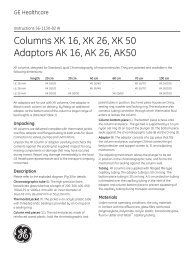
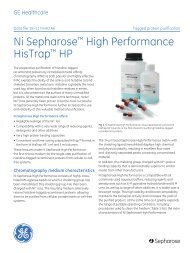
![[PDF] Sample preparation for analysis of protein, peptides and ...](https://img.yumpu.com/21549715/1/190x257/pdf-sample-preparation-for-analysis-of-protein-peptides-and-.jpg?quality=85)
![[PDF] MBP-tagged protein purification](https://img.yumpu.com/21548507/1/184x260/pdf-mbp-tagged-protein-purification.jpg?quality=85)
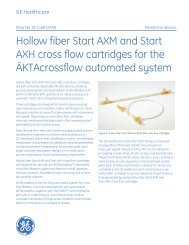
![[PDF] AKTA ready system Data file](https://img.yumpu.com/21540925/1/190x253/pdf-akta-ready-system-data-file.jpg?quality=85)
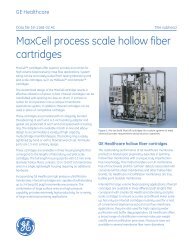
![[PDF] Data File - rProtein A/Protein G GraviTrap](https://img.yumpu.com/21539052/1/190x253/pdf-data-file-rprotein-a-protein-g-gravitrap.jpg?quality=85)
